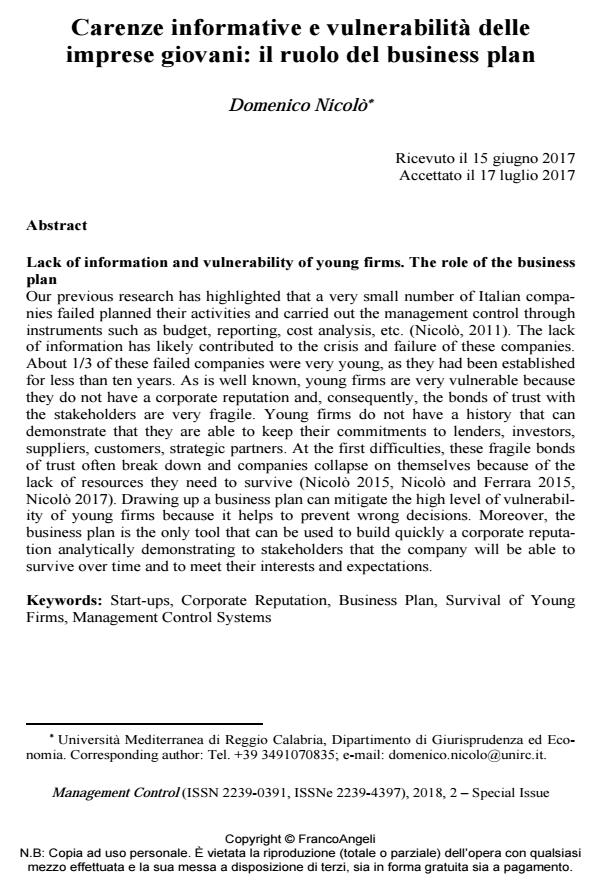Lack of information and vulnerability of young firms. The role of the business plan
Journal title MANAGEMENT CONTROL
Author/s Domenico Nicolò
Publishing Year 2018 Issue 2018/2 Suppl.
Language Italian Pages 16 P. 37-52 File size 219 KB
DOI 10.3280/MACO2018-SU2003
DOI is like a bar code for intellectual property: to have more infomation
click here
Below, you can see the article first page
If you want to buy this article in PDF format, you can do it, following the instructions to buy download credits

FrancoAngeli is member of Publishers International Linking Association, Inc (PILA), a not-for-profit association which run the CrossRef service enabling links to and from online scholarly content.
Our previous research has highlighted that a very small number of Italian compa-nies failed planned their activities and carried out the management control through instruments such as budget, reporting, cost analysis, etc. (Nicolò, 2011). The lack of information has likely contributed to the crisis and failure of these companies. About 1/3 of these failed companies were very young, as they had been established for less than ten years. As is well known, young firms are very vulnerable because they do not have a corporate reputation and, consequently, the bonds of trust with the stakeholders are very fragile. Young firms do not have a history that can demonstrate that they are able to keep their commitments to lenders, investors, suppliers, customers, strategic partners. At the first difficulties, these fragile bonds of trust often break down and companies collapse on themselves because of the lack of resources they need to survive (Nicolò 2015, Nicolò and Ferrara 2015, Nicolò 2017). Drawing up a business plan can mitigate the high level of vulnerability of young firms because it helps to prevent wrong decisions. Moreover, the business plan is the only tool that can be used to build quickly a corporate reputation analytically demonstrating to stakeholders that the company will be able to survive over time and to meet their interests and expectations.
Keywords: Start-ups, Corporate Reputation, Business Plan, Survival of Young Firms, Management Control Systems
- Management accounting systems in venture capital-backed start-up companies Simone Aresu, Luigi Rombi, Andrea Cardia, in MANAGEMENT CONTROL 3/2019 pp.35
DOI: 10.3280/MACO2019-003003 - Managing uncertainty in the start-up environment. Is a business plan an incentive or a limitation? Giovanna Mariani, Davide Morelli, Leonardo Bartoloni, in MANAGEMENT CONTROL 1/2019 pp.73
DOI: 10.3280/MACO2019-001004
Domenico Nicolò, Carenze informative e vulnerabilità delle imprese giovani: il ruolo del business plan in "MANAGEMENT CONTROL" 2 Suppl./2018, pp 37-52, DOI: 10.3280/MACO2018-SU2003